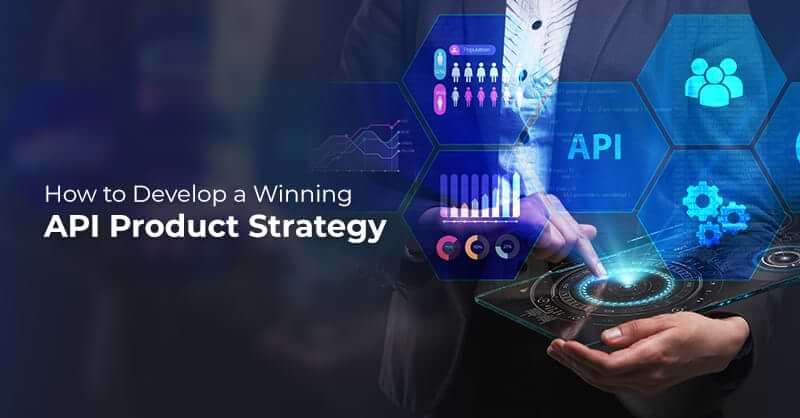How to Develop a Winning API Product Strategy

Written by Harini Krishnamurthy
Senior Lead – Content Writer
December 16, 2022
Every company wants to succeed in the digital economy. Businesses, therefore, must alter their product design and management procedures as consumers turn away from tangible things and focus on digital experiences. In addition, information now drives enormous value. As a result, businesses are increasingly searching for innovative ways to improve data exchange between internal applications and make their data assets more accessible to the platform economy. According to a recent Accenture research, 81% of executives predicted that platform-based business models would be a key component of their growth strategy in three years.
In this new digital transformation era, APIs play a crucial role. Developers use APIs to consume third-party services to facilitate their customers, perform single sign-on for identity verifications, shipment tracking, financial and non-financial services, etc. Today most businesses run on APIs. An API governance approach is crucial to fully utilize an API offering’s potential and provide a service that both internal and external developers can use. We have designed a straightforward Governance framework for considering your complete API development and delivery to develop a winning & product-driven, customer-centric approach. These measures can aid you in your quest to create a great and successful API strategy.
Understand the Function of your API
What issue does your API offer claim to address? For example, you may establish better success criteria, create a sustainable and scalable development strategy, and expedite stakeholder buy-in using an outcome-driven approach to API development. Several well-known applications of APIs include:
- Exposing all internal services via APIs will speed up development and create an adaptive architecture, according to Amazon.
- Establishing a successful API platform to increase user engagement – Facebook, LinkedIn, etc.
It’s critical to completely comprehend your API’s function to determine how it fits within your company’s taxonomy. From a functional standpoint, this taxonomy is made up of smaller building components for your company. To conceptualize the precise function of your API and how it integrates with your present business, it is helpful to identify this and define the issue area of your API.
Build up your API Gradually
Building APIs that offer your customers enormous value is part of having a product-driven approach. The build-measure-learn methodology is a tried-and-true strategy for producing APIs that users adore. This directly borrows from the Lean Startup technique, which involves formulating a set of assumptions about the reliability of your product and then repeatedly proving and refuting those assumptions. To eventually produce a fantastic API, APIs are steadily constructed with regular stakeholder and customer feedback in each iteration.
We can categorize development into each stage of its distinct life cycle. However, it should be highlighted that each of these stages needs a solid tool infrastructure that supports your firm’s culture, methodology, and practices. For example, development teams can design and create APIs in a collaborative setting with the aid of tools like SwaggerHub, Apiary, and Reprezen.
- Design the API
- Virtualizing the API’s Dependencies
- Building the API’s Business Logic
- Testing the API
- Creating the API Documentation
Specify KPIs
A Key Performance Indicator (KPI) is a quantifiable metric that shows how well your API is accomplishing its goals as a business. It is important to know the precise metrics by which your API application will be judged as it is being developed. It’s simple to get lost in a sea of potential KPIs you may use to gauge your progress; therefore, it can be helpful to connect your measurable results to your API’s goal and target audience. There are two different metrics that you should compare yourself against.
Metrics for the Audience Journey
This is determined by tracking the numerous steps your end user must take to access and use your API. Here is a typical KPI for a conventional API paradigm: When developing a private API, which might not necessitate the same level of thoroughness, the significance of assessing oneself against quantitative criteria might diminish. Stories and qualitative feedback can also be valuable benchmarks for private APIs to compare your API.
Metrics for Business Goals
These metrics are more directly related to the goal of your API. If your API business is partner- or public-based, price and growth are reliable measures of your API success. The quantity of applications and procedures that integrate with your API is an excellent indicator of success if it is intended just for private, internal use. Here are a few illustrations of KPIs focused on business.
Gathering and Utilizing Feedback
When gathering input on the usefulness and quality of your API for commercial purposes, the metrics you defined above might assist you in creating benchmarks. After completing the aforementioned steps, publish the APIs on a simple portal to allow consumption by the appropriate parties and collect feedback. In this step, the main goal is to gather some insightful input from a small first sample of potential users. This stage consists of two components:
- Locating early adopters who can offer you feedback. You can take advantage of your connections with some of your current clients or look for early adopters in channels where they frequently congregate. Finding early adopters can be made easier by using Lean Startup
- Gathering, compiling and iterating on the feedback.
This feedback needs to be swiftly analyzed and addressed as part of the build-measure-learn concept. Then, fresh input is incorporated into the design and development of the API, resulting in regular upgrades.
Promoting the API
To effectively market your API, you must inform customers of its advantages and argue for its inclusion in developers’ toolkits. In addition, you want to ensure that your APIs are internally and externally discovered and used. Inbound content, which includes inbound messaging and documentation, is typically combined with outbound evangelizing in marketing. The many steps to building a successful API program around your API should be explained in detail, such as steps like establishing and maintaining developer contacts, generating tutorials, and developing an advocacy program around your APIs.
Conclusion
The basis of product strategy is creating APIs with the end user in mind. They are essential instruments for business. Clear goals that are directly related to business objectives and closely follow key performance indicators (KPIs) for the business are necessary for successful APIs. Royal Cyber team can assist you in focusing on business strategy, particularly developing your initial idea of how developing an API will assist in achieving company objectives. Get in touch with our Royal Cyber experts, who can assist you in developing a winning API Product Strategy. To know more, contact us at [email protected] or visit www.royalcyber.com.
Recent Blogs
- Middleware is often considered the glue that binds different systems and connecting platforms, and it …Read More »
- Learn to write effective test cases. Master best practices, templates, and tips to enhance software …Read More »
- In today’s fast-paced digital landscape, seamless data integration is crucial for businessRead More »






